|
| |
- This page contains pictures and information about Jumping Spiders that we
found in the Brisbane area, Queensland, Australia.
-
 -
- Jumping Spider is a very large family contains the most colourful species of spiders.
They are small to medium size. They
are easily recognized by their eyes pattern. Their front pair of eyes are very
large with, with another three pair of smaller eyes on thorax, in three row of
4-2-2. They have very good eyesight and active during the day. They arrangements
of their four pairs of eyes made their vision covers virtually entire 360 degree
around the spider.
-
- Each species in this family have different colourful patterns on
their body. When you look at them, they will either hide away on
the other side of the leaf or will turn their head and look back at
you.
-
-


-
- Jumping spiders are called Pussy Cat in Chinese. The above picture shows a
Jumping Spider with a cat's face, this may explain why they are called.
-
  -
- Jumping spiders do not build webs. They make silken retreats between leaves, barks or stones.
Their retreats usually have opening at both ends. They hide in their
retreats at night and during winter.
-
- The females lay eggs in their
retreats in spring and summer. Their number of eggs is relatively fewer than
most other spiders. Female spiders will guard their eggs. Usually Jumping
Spiders will not hunt too far away from their retreats. Male and female may
live together in mating season. This is not common in the spider world.
-
-
 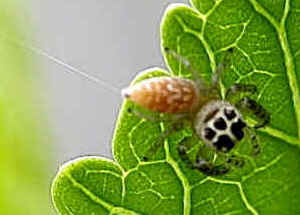
-
- When Jumping Spiders move or jump, they always leave a
safety line of silk, or the drag-line, behind. Look carefully at the about first
pictures
you will see the drag-line attached from the spider abdomen tip to a leaf. If the jump
missed the spiders can climb back to its
original position.
-
- Jumping Spiders hunt on plants during the day. They have complex eyes system
and considered to be the best vision among all the animals of their size. The
eyes of jumping spider, especially the largest pair of eyes, are constructed
very differently from vertebrate and insect eyes. Each eye has a long eye tube
which is attached with a set of muscles, it is capable of precise rotate and
move. However, jumping spider's eyes can not adjust the focus. The retinas have
a four-layer and tiered arrangement. There is another lens just in front of the
retina. This makes the spider's eyes a telephoto lens system. The spider can see
sharp image ranging from one body length to infinity. It is also believed the
jumping spider can see colours.
-
- They use their excellent vision to
track the prey and estimate distance. Then suddenly jump on their prey. They
use their third and fourth pair of legs for jumping. They seize prey by front
pair of legs.
-
-
Jumping Spiders are the predator of small spiders and insects. However, we
found that Jumping spiders are the prey of the Mud-Dauber
Wasps.
-
- Followings are the different species of Jumping Spiders that we found in
Brisbane.
- Green Jumping Spider, Northern Green
Jumping Spider
  - Mopsus mormon, male body length 15mm, female body length 10mm
- Green Jumping Spider is the largest jumping spider in Australia. This is a beautiful large Jumping Spider. Its body is bright green in
colour with dark red head. The front pair of big eyes occupy half of its dark
face, below are the very large fangs. On the abdomen there is the white colour
on green with two black lines. Its legs are green to dark red in colour. The
male and female look slightly different. The male has the hairy white crown around its head.
Female is smaller and with patterned thorax. More pictures and information can
be found in this page.
-
-
- Wattle Jumping Spider
  - Sandalodes scopifer (former S. albobarbatus), body length 8mm
- We found this Jumping Spider on wattle leaf and stem a few times. It has the very
long and strong front legs. Its front pair eyes are large and with eyebrow. The white markings on this black spider are distinctive. The patterns are
variable in different individuals. This spider is common in eucalypt forests
in Brisbane. More details please click on here.
-
-
- Ludicra Jumping Spider
  - Sandalodes superbus, female, body length 12mm
- This is quite a large jumping spider. We sometimes found them hunting on
young Eucalyptus tree. Click here
for more pictures and information.
-
-
- Biting Jumping Spider
 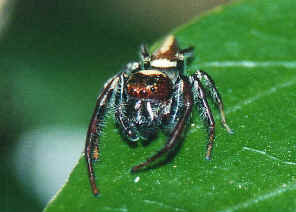 - Opisthoncus mordax, body length 10mm
- We found this jumping spider hunting on leave during day time. It body is shiny
black in colour, with a with line on the middle of its abdomen. The first pair
of legs are strong and with spines. This Jumping Spider is common in Brisbane gardens and
backyards. Click here for more
pictures and information.
-
-
- Garden Jumping Spider
-
 
- Opisthoncus sp., body length 10mm
- The spider is brown in colour with
white pattern on its abdomen and thorax. The spider hunt actively during day time.
The spider is usually found hunting on green leaves. Garden Jumping Spider
is common in garden and backyard in Brisbane. Click here
for more pictures and information.
-
-
- Small Garden Jumping Spider
  - Opisthoncus polyphemus, body length 6mm
- This is a small jumping spider, with distinct black and white patterns on
thorax. This spider is common is Brisbane gardens and backyards. They
usually hunting on small shrubs and low trees. Above pictures were taken in
our backyard in Eight Mail Plains. Please visit this page
for more information on this spider.
-
-
- Small Striped Jumping Spider
 - Lycidas scutulata, (former Sigytes scutulata), body length
6mm
- We found this small spider once on Dec 2007 along Bulimba Creek in
Sunnybank. It was hunting on short grasses.
- Reference:
- 1. Australian Spiders in colour - Ramon Mascord, Reed Books Pty
Ltd, 1970, p28
- 2. Lycidas
sp. - The
Find-a-spider Guide for Australian Spiders, University of Southern
Queensland, 2007.
-
-
- Cytaea Jumping Spider

 - Cytaea alburna, body length 10mm
- We found this spider once. Pictures taken on Aug 2007. Please also visit
this page for this spider.
-
-
- Chink Jumping Spider

 - Holoplatys complanata, body length 12mm
- This is a large Jumping Spider. It hunts on gum tree trunk by jumping down
to prey land on the tree trunk. The spider has a flattened brown abdomen that is an elongate oval shape. More
information and pictures please click on here.
-
-
- Bark Jumping Spider

 - Holoplatys planissima, body length 10mm
- Found this spider under loose gum tree bark in Karawatha Forest Nov 2008.
This spider has dark brown thorax and pale brown abdomen. On abdomen there
are two lines run along. It has the flat body makes it suitable to move
under loose bark. It moves quickly with jerky motion.
- Reference:
- 1. Australian Spiders in colour - Ramon Mascord, Reed Books Pty Ltd,
1970, p28
- 2. Holoplatys planissima
- The Find-a-spider Guide for Australian
Spiders, University of Southern Queensland, 2008.
-
-
- Flat Jumping Spider

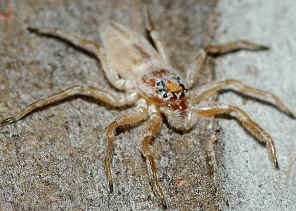 - Arasia mollicoma, body length 15mm
- This spider has a flatten body and long abdomen. It is pale brown in
colour. It was found a few times in Karawatha Forest on gum tree trunk during late
summer. Click on here for more
details.
-
-
- Small Bark Jumper

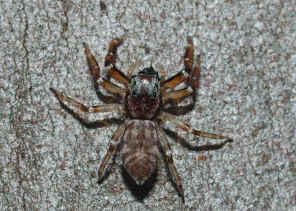 - Tauala sp., body length 10mm
 - Pictures were taken on Oct 2007 in Karawatha Forest, Dentata Track.
- 1. Tauala
species - The Find-a-spider Guide for Australian
Spiders, University of Southern Queensland, 2007.
-
-
- Salticid Ant Eater
  - Zenodorus orbiculatus, body length 6mm
- We can easily find this small Jumping Spiders on gum and wattle tree trunks.
The spider shiny black or dark brown, with a white line circle the edge of
its abdomen. Some with a white dot at the centre. We saw the spiders feeding on different species of ants many
times. More information and pictures please visit this page.
-
-
- Aussie Bronze Jumper
  - Helpis minitabunda female body length 8mm
Male body length 10mm
- This is another species of Jumping Spider, with slender body light brown in
colour. In the above picture, one leg of the spider is missing. More
information can be found in this page.
-
-
- Brown Jumper

 - ? Simaetha thoracica, body length 6mm
- We sometimes find this jumping spider hunting on wattle leaves and stems
in eucalypt forest. More pictures and information can be found in this page.
-
-
- Bark Jumper

 - ? Servaea sp. or Plexippus sp., body length 8mm
- We sometimes found this jumping spider wandering on gum tree trunks. It
hide under bark when we come closer, so we call it Bark Jumper. More
information and pictures can be found in this page.
-
-
- Long-jawed Jumping Spider

 - ? Cosmophasis sp., body length 10mm
- Reference:
- 1. Jumping spiders Family Salticidae - by Ed Nieuwenhuys,
26 November 2006.
-
-
- Golden Tail Jumper
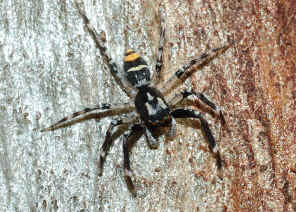
 - Astia hariola, body length 8mm, male
- We found this Golden Tail Jumping Spider once in Karawatha Forest on Aug
2007. The spider was hunting on a large smooth bark gum tree trunk. More
pictures and information can be found in this page.
-
-
-
- Golden Ant-mimicking Spider

 - Myrmarachne sp., body length 8mm
- Some Jumping Spiders mimic ants. They mimic in body shape and colour
patterns. This Golden Ant-mimicking Spider walk like an ant too. The spider hide among ants
without being detected. It waves their front legs just like the ant's
antenna. This spider is found in a line of ants on a gum tree trunk. For
more information please go to this page.
-
-
- Small Black Ant-mimicking Spider
  - Myrmarachne sp., body length 5mm
- This Jumping Spider just looks like an small black ant. The first picture
shows its retreat. This small jumping spider has relatively strong front arms.
Please visit this page for more information.
-
-
- Brown Ant-mimicking Spider

 - Myrmarachne striatipes, body length 8mm
-
- There are Un-identified Jumping Spiders in this page.
-
- Reference:
- 1. A Guide to Australian Spiders - Densey Clyne, Melbourne, Nelson
1969, p51.
- 2. SALTICIDAE Blackwall, 1841 - Australian Biological Resources Study.
- 3. PREDATORY BEHAVIOR OF JUMPING SPIDERS
- R.R. Jackson and S.D. Pollard, Annual Review of Entomology, Vol. 41: 287-308 (January 1996).
- 4. Australia - List of Species of Salticidae - by Jerzy Proszynski, 1999.
-
- Back to top
[ Up ] [ Two-Tails Spiders ] [ Lynx spiders ] [ Wolf spiders ] [ Water Spiders ] [ Ground Hunting Spiders ] [ Long-legged Sac Spiders ] [ Swift spiders ] [ Jumping spiders ] [ Wall crab spiders ] [ Huntsman Spiders ] [ Crab Spiders ] [ Unknown Hunting Spiders ] |

















































